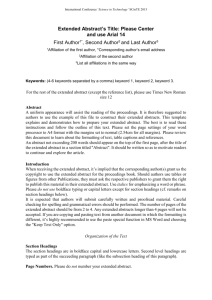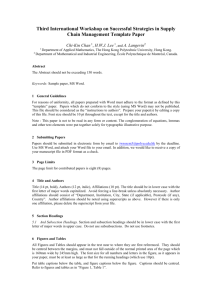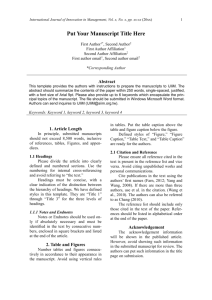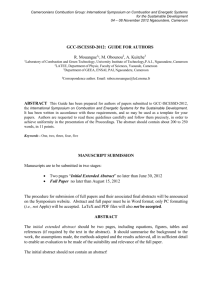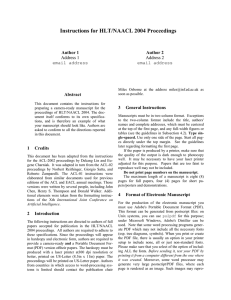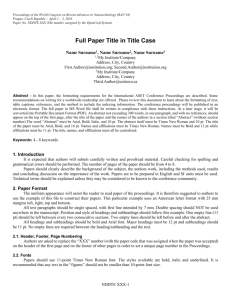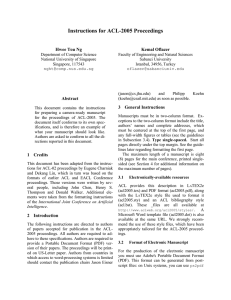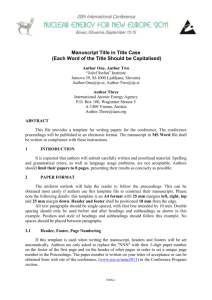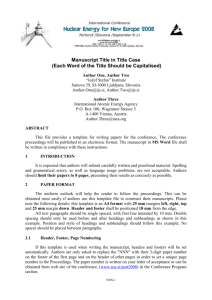Word format
advertisement
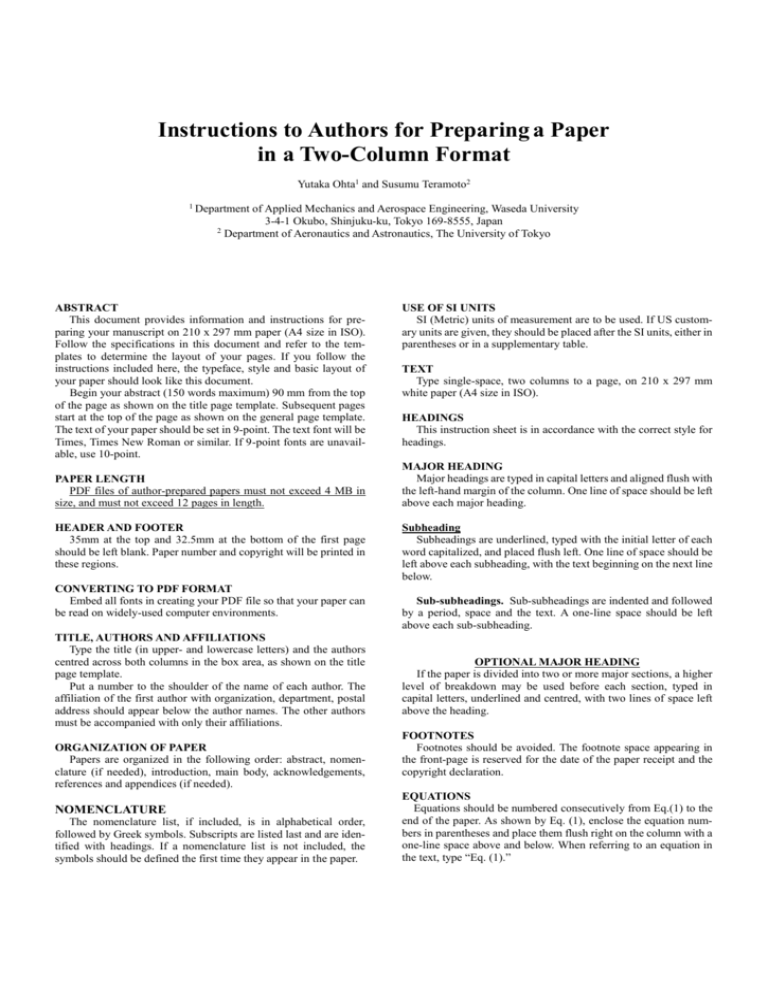
Instructions to Authors for Preparing a Paper in a Two-Column Format Yutaka Ohta1 and Susumu Teramoto2 1 Department of Applied Mechanics and Aerospace Engineering, Waseda University 3-4-1 Okubo, Shinjuku-ku, Tokyo 169-8555, Japan 2 Department of Aeronautics and Astronautics, The University of Tokyo ABSTRACT This document provides information and instructions for preparing your manuscript on 210 x 297 mm paper (A4 size in ISO). Follow the specifications in this document and refer to the templates to determine the layout of your pages. If you follow the instructions included here, the typeface, style and basic layout of your paper should look like this document. Begin your abstract (150 words maximum) 90 mm from the top of the page as shown on the title page template. Subsequent pages start at the top of the page as shown on the general page template. The text of your paper should be set in 9-point. The text font will be Times, Times New Roman or similar. If 9-point fonts are unavailable, use 10-point. PAPER LENGTH PDF files of author-prepared papers must not exceed 4 MB in size, and must not exceed 12 pages in length. HEADER AND FOOTER 35mm at the top and 32.5mm at the bottom of the first page should be left blank. Paper number and copyright will be printed in these regions. CONVERTING TO PDF FORMAT Embed all fonts in creating your PDF file so that your paper can be read on widely-used computer environments. TITLE, AUTHORS AND AFFILIATIONS Type the title (in upper- and lowercase letters) and the authors centred across both columns in the box area, as shown on the title page template. Put a number to the shoulder of the name of each author. The affiliation of the first author with organization, department, postal address should appear below the author names. The other authors must be accompanied with only their affiliations. ORGANIZATION OF PAPER Papers are organized in the following order: abstract, nomenclature (if needed), introduction, main body, acknowledgements, references and appendices (if needed). NOMENCLATURE The nomenclature list, if included, is in alphabetical order, followed by Greek symbols. Subscripts are listed last and are identified with headings. If a nomenclature list is not included, the symbols should be defined the first time they appear in the paper. USE OF SI UNITS SI (Metric) units of measurement are to be used. If US customary units are given, they should be placed after the SI units, either in parentheses or in a supplementary table. TEXT Type single-space, two columns to a page, on 210 x 297 mm white paper (A4 size in ISO). HEADINGS This instruction sheet is in accordance with the correct style for headings. MAJOR HEADING Major headings are typed in capital letters and aligned flush with the left-hand margin of the column. One line of space should be left above each major heading. Subheading Subheadings are underlined, typed with the initial letter of each word capitalized, and placed flush left. One line of space should be left above each subheading, with the text beginning on the next line below. Sub-subheadings. Sub-subheadings are indented and followed by a period, space and the text. A one-line space should be left above each sub-subheading. OPTIONAL MAJOR HEADING If the paper is divided into two or more major sections, a higher level of breakdown may be used before each section, typed in capital letters, underlined and centred, with two lines of space left above the heading. FOOTNOTES Footnotes should be avoided. The footnote space appearing in the front-page is reserved for the date of the paper receipt and the copyright declaration. EQUATIONS Equations should be numbered consecutively from Eq.(1) to the end of the paper. As shown by Eq. (1), enclose the equation numbers in parentheses and place them flush right on the column with a one-line space above and below. When referring to an equation in the text, type “Eq. (1).” m+n+p=p+n+m (1) TABLES AND FIGURES Tables and figures are placed in two columns on the page or centred. If figures or tables are centred on the page, they should be placed at the top or the bottom of the page. Table captions should be put above the table. Figure captions and any explanatory legends are below the figure. Leave an appropriate space (one line or two) between tables or figures and text. Fig. 1 Turbine efficiency of ceramic wheel and metal wheel Coloured figures, graphs and line drawings are acceptable unless the PDF file size exceeds the limit. Photographs should be in a high contrast. Lettering must be large enough to be legible (a minimum height of 1.5 mm (0.06 inches) is recommended). Tables and figures must be placed in appropriate positions on the pages. This instruction gives (below) one table and one figure (above) in two-column format as examples. Table. 1 Mean fracture speed and the calculated stress of model wheels Fracture speed Calculated stress at typical portions (MPa) (rpm) A B C Model 1 189.000 344 400 314 Model 2 200.000 171 408 372 REFERENCES Within the text, references should be cited in numerical order according to their order of appearance. The numbered reference citation should be enclosed in brackets. In the case of two citations, the number should be separated by a comma (e.g., [1, 2]). In the case of more than two reference citations, the numbers should be separated by a dash (e.g., [1-3]). References to the original sources for cited material should be listed together at the end of the paper; footnotes should not be used for this purpose. References should be arranged in numerical order according to their order of appearance within the text. (1) Reference to journal articles, papers in conference proceedings, or any other collection of works by numerous authors should include a) last name of each author followed by their initials b) year of publication c) full title of the cited article d) full name of the publication in which it appeared (in italics) e) volume numbers (if necessary) f) inclusive page numbers of the cited material. (2) Reference to textbooks, monographs, theses, and technical reports should include a) last name of each author followed by their initials b) year of publication c) full title of the publication (in italics) d) publisher e) city of publication f) inclusive page numbers of the material In all cases, titles of books, periodicals, and conference proceedings should be in italics. A sample list of references is given below. Sample List of References [1] Lee, Y., Korpela, S. A., and Horne, R. N., 1982, “Structure of Multi-Cellular Natural Convection in a Tall Vertical Annulus,” Proceedings, 7th International Heat Transfer Conference, U. Grigul et al., ed., Hemisphere Publishing Corp., Washington, D.C., Vol. 2, pp. 221-226. [2] Sparrow, E. M., 1980, “Fluid-to-Fluid Conjugate Heat Transfer for a Vertical Pipe - Internal Forced Convection and External Natural Convection,” ASME Journal of Heat Transfer, Vol. 102, pp. 402-407. [3] Tung, C. Y., 1990, “Evaporative Heat Transfer in the Contact Line of a Mixture,” Ph.D. Thesis, Rensselaer Polytechnic Institute, Troy, NY. PAGE NUMBERS Put the page number at the bottom of each page in the same manner as this document. SUBMISSION OF PDF MANUSCRIPTS Each author is required to prepare the manuscript for review (draft paper) and the final paper in accordance with the format described in and illustrated by this document, and to submit the PDF files of these on-line through https://controls.papercept.net/conferences/scripts/start.pl Templates of Microsoft Word 2010 or later can be downloaded from the web site, http://www.gtsj.org/english/igtc/IGTC2015/ The deadline of the full-length draft paper for review is April 30, 2015. Final acceptance of the drafts will be notified by June 30, 2015. The deadline of the final paper manuscripts is August 31, 2015. If you have any inquiries about your manuscript, please contact: Prof. Yutaka OHTA (Waseda University) E-mail: igtc2015-paper@gtsj.org FINAL MANUSCRIPT FOR USB FLASH MEMORY PROCEEDINGS The authors are requested to submit the final papers for flash memory proceedings. PRE-REGISTRATION It is not possible to submit the final paper until your registration and fee payment is completed. On the registration system (AMARYS), you will be required to enter your papercept submission number. After payment of registration fees is completed you will receive a confirmation e-mail which will include a "keycode" associated with your paper. This "keycode" will be required on the papercept site for final paper submission. FURTHER INFORMATION For further information, please visit our web site at http://www.gtsj.org/english/igtc/IGTC2015/

